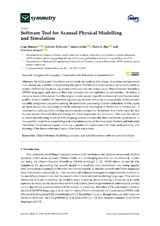Software Tool for Acausal Physical Modelling and Simulation
Autor
Jiménez Hornero, Jorge
Belmonte, Antonio
Garrido, J.
Ruz Ruiz, Mario L.
Vázquez Serrano, Francisco J.
Editor
MDPIFecha
2019Materia
Object-Oriented ModellingComplex and hybrid systems
Software tool
Simulation
METS:
Mostrar el registro METSPREMIS:
Mostrar el registro PREMISMetadatos
Mostrar el registro completo del ítemResumen
Modelling and simulation are key tools for analysis and design of systems and processes from almost any scientific or engineering discipline. Models of complex systems are typically built on acausal Differential-Algebraic Equations (DAE) and discrete events using Object-Oriented Modelling (OOM) languages, and some of their key concepts can be explained as symmetries. To obtain a computer executable version from the original model, several algorithms, based on bipartite symmetric graphs, must be applied for automatic equation generation, removing alias equations, computational causality assignment, equation sorting, discrete-event processing or index reduction. In this paper, an open source tool according to OOM paradigm and developed in MATLAB is introduced. It implements such algorithms adding an educational perspective about how they work, since the step by step results obtained after processing the model equations can be shown. The tool also allows to create models using its own OOM language and to simulate the final executable equation set. It was used by students in a modelling and simulation course of the Automatic Control and Industrial Electronics Engineering degree, showing a significant improvement in their understanding and learning of the abovementioned topics after their assessment.

